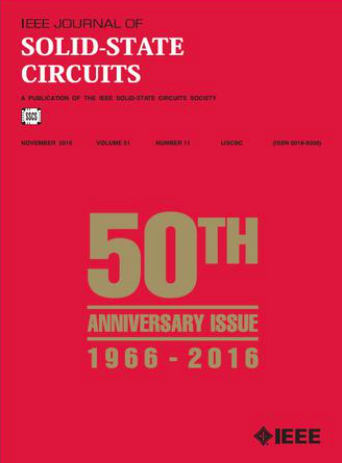毫米磁电生物医学植入物的全向无线功率传输
IF 4.6
1区 工程技术
Q1 ENGINEERING, ELECTRICAL & ELECTRONIC
引用次数: 0
摘要
微型生物电子植入物有望为心血管和神经疾病带来革命性的治疗方法。无线电力传输(WPT)是实现微型化的重要方法,它消除了当今设备对笨重电池的需求。尽管在动物模型中成功展示了毫米级无电池植入物,但众所周知,在身体运动、呼吸、心脏跳动以及手术过程中对植入物方向的有限控制所造成的错位情况下,WPT 的稳健性和效率会显著下降。本文介绍了一种用于毫米级生物电子植入物的全向 WPT 平台,该平台采用了新兴的磁电 (ME) WPT 模式和基于多个发射器 (TX) 线圈的 "磁场转向 "技术。为了准确感知微型植入体中的弱耦合,并在闭环中自适应地控制多线圈 TX 阵列,我们利用植入体上的微型线圈开发了一种主动回声(AE)方案。我们的原型包括一个完全集成的 14.2 mm3 植入式刺激器,内嵌一个由 ME 薄膜供电的定制低功耗片上系统 (SoC)、一个带有定制三通道 AE RX 芯片的 TX 和一个具有互感消除功能的多线圈 TX 阵列。AE RX 的输入参考噪声为 -161 dBm/Hz,增益调整范围为 64 dB,能够可靠地感应 AE 信号,并为驱动器控制提供快速极性检测。AE 同时增强了 ME WPT 的稳健性、效率和充电范围。在从理想位置旋转 90° 的情况下,我们的全向 WPT 系统的功率传输效率(PTE)比单线圈基线高出 6.8{ times }$。与使用理想控制相比,AE 的跟踪误差可忽略不计地降低了 PTE,降幅不到 2%。本文章由计算机程序翻译,如有差异,请以英文原文为准。
Omnidirectional Wireless Power Transfer for Millimetric Magnetoelectric Biomedical Implants
Miniature bioelectronic implants promise revolutionary therapies for cardiovascular and neurological disorders. Wireless power transfer (WPT) is a significant method for miniaturization, eliminating the need for bulky batteries in today’s devices. Despite successful demonstrations of millimetric battery-free implants in animal models, the robustness and efficiency of WPT are known to degrade significantly under misalignment incurred by body movements, respiration, heart beating, and limited control of implant orientation during surgery. This article presents an omnidirectional WPT platform for millimetric bioelectronic implants, employing the emerging magnetoelectric (ME) WPT modality, and “magnetic field steering” technique based on multiple transmitter (TX) coils. To accurately sense the weak coupling in a miniature implant and adaptively control the multicoil TX array in a closed loop, we develop an active echo (AE) scheme using a tiny coil on the implant. Our prototype comprises a fully integrated 14.2 mm3 implantable stimulator embedding a custom low-power system-on-chip (SoC) powered by an ME film, a TX with a custom three-channel AE RX chip, and a multicoil TX array with mutual inductance cancellation. The AE RX achieves −161 dBm/Hz input-referred noise with 64 dB gain tuning range to reliably sense the AE signal, and offers fast polarity detection for driver control. AE simultaneously enhances the robustness, efficiency, and charging range of ME WPT. Under 90° rotation from the ideal position, our omnidirectional WPT system achieves
$6.8{ \times }$
higher power transfer efficiency (PTE) than a single-coil baseline. The tracking error of AE negligibly degrades the PTE by less than 2% from using ideal control.
求助全文
通过发布文献求助,成功后即可免费获取论文全文。
去求助
来源期刊

IEEE Journal of Solid-state Circuits
工程技术-工程:电子与电气
CiteScore
11.00
自引率
20.40%
发文量
351
审稿时长
3-6 weeks
期刊介绍:
The IEEE Journal of Solid-State Circuits publishes papers each month in the broad area of solid-state circuits with particular emphasis on transistor-level design of integrated circuits. It also provides coverage of topics such as circuits modeling, technology, systems design, layout, and testing that relate directly to IC design. Integrated circuits and VLSI are of principal interest; material related to discrete circuit design is seldom published. Experimental verification is strongly encouraged.
 求助内容:
求助内容: 应助结果提醒方式:
应助结果提醒方式:


